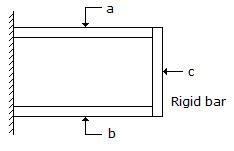Civil Engineering - Strength of Materials - Discussion
Discussion Forum : Strength of Materials - Section 3 (Q.No. 17)
17.
A composite member shown in below figure was formed at 25°C and was made of two materials a and b. If the coefficient of thermal expansion of a is more than that of b and the composite member is heated upto 45°C, then


Discussion:
13 comments Page 1 of 2.
Gokul said:
4 years ago
Steel is coefficient of thermal expansion 12x10^ -6c .
Taken brass coefficient of thermal expansion is 16x10^-6c.
In composite beam, the steel is tensile in nature if the coefficient of thermal expansion is less and brass is compressive if the coefficient of thermal expansion is more.
Taken brass coefficient of thermal expansion is 16x10^-6c.
In composite beam, the steel is tensile in nature if the coefficient of thermal expansion is less and brass is compressive if the coefficient of thermal expansion is more.
Shah Sawar said:
4 years ago
The given answer is correct.
In composite members, both bars have to produce the same strain.
Now "a" bar due to its high coefficient of thermal expansion will tend to produce a higher strain than "b" bar and to fulfil the requirement of the same strain, tension is produced in "b" bar and compressive stresses in "a" bar.
In composite members, both bars have to produce the same strain.
Now "a" bar due to its high coefficient of thermal expansion will tend to produce a higher strain than "b" bar and to fulfil the requirement of the same strain, tension is produced in "b" bar and compressive stresses in "a" bar.
(1)
Muhammad usman said:
6 years ago
If we see the figure bar a will elongate more is compare to b so a rigid bar c try to push the bar a inward and bar b outward to keep in equilibrium so the comparison is developed in a and tension in b.
Silence said:
6 years ago
Since the movement is restricted by the rigid support at C so both should be in compression.
(2)
Prachi said:
6 years ago
I also agree @Jishan.
Both will try to expand because the rate of expansion of bar A will be more as compared to bar B so both will experience compressive force.
Both will try to expand because the rate of expansion of bar A will be more as compared to bar B so both will experience compressive force.
Aditya said:
7 years ago
Both A and B bars are fixed to the rigid bar C and due to the high temperature, they both try to elongate but due to the rigid bar they can't, so both the bars are under compression but bar A is under more compression because of its higher thermal coefficient.
Shivam kamboj said:
7 years ago
I agree with @Jishan.
Option B is the right answer because it's a rigid bar.
Option B is the right answer because it's a rigid bar.
Jishan said:
8 years ago
Both bars try to elongate (b elongate less than that of a) but due to the rigid bar, their elongations are restricted thus a compression stress develop in both bar.
Azzu said:
8 years ago
In composite members let A and B.
If the coefficient of thermal expansion of A is more than B.
Then, if temp rise occurs A subjected to compression and B will be subjected to tension.
If the coefficient of thermal expansion of A is more than B.
Then, if temp rise occurs A subjected to compression and B will be subjected to tension.
Kallan said:
8 years ago
The load is compressive. So the answer is correct.
Post your comments here:
Quick links
Quantitative Aptitude
Verbal (English)
Reasoning
Programming
Interview
Placement Papers